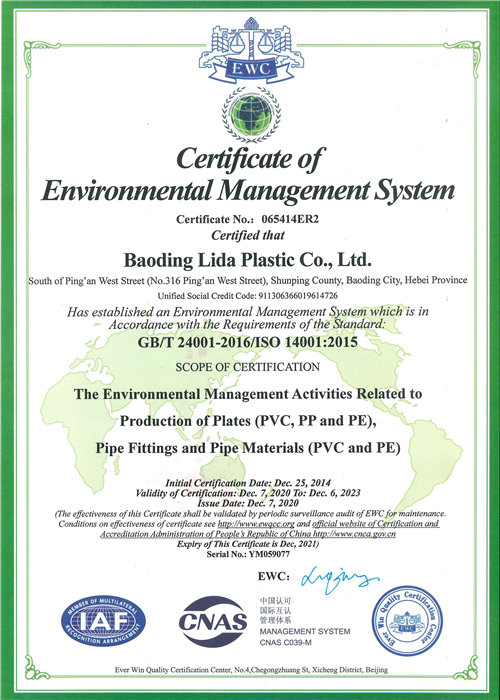Nov . 06, 2024 11:13 Back to list
HDPE Reinforced Spiral Corrugated Pipe for Enhanced Strength and Durability Applications
The Advantages of HDPE Reinforced Spiral Corrugated Pipe
In the realm of modern engineering and construction, the importance of durable and efficient materials cannot be overstated. Among the various options available, HDPE (High-Density Polyethylene) reinforced spiral corrugated pipe stands out as a leading choice for various applications, particularly in drainage, sewage, and industrial systems. This article delves into the unique benefits of HDPE reinforced spiral corrugated pipes and why they are becoming increasingly popular in construction projects worldwide.
Understanding HDPE and Its Properties
High-Density Polyethylene (HDPE) is a thermoplastic polymer known for its high strength-to-density ratio, making it an ideal choice for numerous applications. HDPE is resistant to impact, corrosion, and chemical leaching, which ensures that it maintains its structural integrity over time. Additionally, it is lightweight and flexible, allowing for easy handling and installation. These inherent properties contribute significantly to the performance of HDPE reinforced spiral corrugated pipes.
The Design and Structure of Spiral Corrugated Pipes
Spiral corrugated pipes are distinguished by their unique design, consisting of a series of grooves and ridges that spiral along the pipe’s length. This design not only enhances the pipe's structural integrity but also improves its hydraulic performance. The corrugation provides added strength while allowing for efficient flow of liquids, making these pipes suitable for various applications, including stormwater management systems, sewer systems, and agricultural drainage.
Reinforcement is a critical aspect of these pipes, as it enhances their load-bearing capacity. HDPE reinforced spiral corrugated pipes are designed to withstand high external pressures without deforming, which is particularly important in heavy load-bearing applications such as road and rail construction.
Advantages of Using HDPE Reinforced Spiral Corrugated Pipes
hdpe reinforced spiral corrugated pipe

1. Durability and Longevity One of the most significant advantages of HDPE reinforced spiral corrugated pipes is their exceptional durability. They are resistant to a wide range of environmental factors, such as UV radiation, chemicals, and biological growth. This resistance translates into a longer lifespan compared to traditional materials like concrete or metal, significantly reducing replacement and maintenance costs.
2. Cost-Effectiveness While the initial investment in HDPE reinforced spiral corrugated pipes might be higher than less durable options, the long-term savings associated with reduced maintenance and longer lifespan make them a cost-effective choice. Furthermore, their lightweight nature reduces transportation costs and enhances installation efficiency.
3. Hydraulic Efficiency The smooth internal surface of these pipes promotes optimal flow, minimizing friction losses. This design feature is particularly beneficial in draining applications where efficient liquid flow is crucial for system performance.
4. Environmental Benefits HDPE is a recyclable material, making these pipes an environmentally friendly choice. Their resistance to leaching also ensures that there is minimal environmental impact during their lifecycle.
5. Versatility HDPE reinforced spiral corrugated pipes can be utilized across various sectors, including construction, agriculture, and municipal infrastructures. Their applicability in different industry sectors illustrates their versatility.
Conclusion
HDPE reinforced spiral corrugated pipes represent a significant advancement in piping technology, combining durability, efficiency, and cost-effectiveness into one resilient product. As construction and engineering continue to evolve, the demand for materials that can withstand the challenges of modern infrastructure increases. By adopting HDPE reinforced spiral corrugated pipes, industries can ensure the longevity and reliability of their systems while contributing to sustainable practices through the use of recyclable materials. As such, these pipes are set to play a critical role in shaping the future of construction and infrastructure development.
-
High-Quality PPR Pipes and Fittings Durable ERA PPR & PVC PPR Solutions
NewsJul.08,2025
-
Black HDPE Cutting Board - Durable, Non-Porous & Food Safe HDPE Plastic Cutting Board
NewsJul.08,2025
-
High-Quality CPVC Panel Durable HDPE & PVC Panels Supplier
NewsJul.08,2025
-
Double PE Welding Rod Supplier - High Strength, Durable & Versatile Welding Solutions
NewsJul.07,2025
-
High-Quality PVC-O Pipe Supplier Durable 75mm PVC Pipe & Connections Leading PVC Pipe Company
NewsJul.07,2025
-
HDPE Drainage Pipe Supplier – Durable & Corrosion-Resistant Solutions
NewsJul.06,2025

